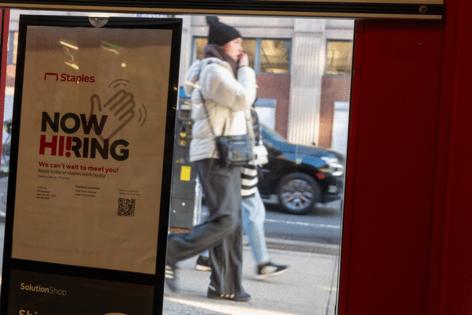Commentary: More than 2 million workers are missing. Who are they, and how are they affecting the economy?
Published in Op Eds
If I were a mystery novelist instead of an economist, I’d call it “The Case of the Missing Workers.”
I’m referring to the fact that there are 2.3 million fewer people employed today than if the employment-to-population ratio had stayed the same as it was four years ago, just before the COVID-19 pandemic. This lack of workers is hurting economic growth and exacerbating the federal government’s unsustainable budget.
Since the output of an economy – its GDP – is directly related to the number of workers producing goods and services, missing workers means a smaller economy.
And not just a little bit smaller. Although the estimated 2.3 million missing workers aren’t counted among the unemployed because they aren’t looking for work, if what they subtract from output (based on a popular economic rule of thumb called Okun’s law) is the same as an unemployed worker, they could be holding annual GDP growth back by 2.6 percentage points, or $700 billion.
But that’s not the only downside. Missing workers have a double-negative impact on the federal budget. That’s because people who aren’t working do not pay employment taxes, and they often do receive federal welfare benefits.
Compared to a median earner who makes about $60,000 a year and pays about $17,000 a year, or $1,400 per month in federal employment taxes, a single, unemployed individual can receive about $2,800 per month in unemployment insurance, food stamps and Medicaid. The difference between contributing $1,400 a month in taxes and taking $2,800 a month in benefits is $4,200 per month.
Based on that monthly difference, 2.3 million missing workers could cost the federal government $116 billion a year in lost revenues and additional welfare spending.
That net loss assumes that the missing individuals are work-capable adults without dependents, but other missing workers could have larger or smaller impacts on the federal budget. A parent who stops working to stay home with young children, for example, will almost always have a positive long-run impact.
So who are the missing workers?
In large part, they’re older Americans who have been able to retire earlier than planned because rising home prices boosted their nest eggs.
But they’re also young Americans in the formative years of their careers. Compared to four years ago, employment among workers ages 20-24 is down by 1.8% and educational enrollment is down by 7%.
This large increase in apparent idleness among young Americans is particularly troubling because periods of unemployment—particularly longer periods—have lasting negative impacts on workers’ lifetime opportunities and earnings, as well as their physical and mental health.
One group that has bucked the employment decline is women with young children at home. Despite the narrative that a lack of child care has caused many women to drop out of the workforce in order to stay home and care for kids, employment has increased 3.1% among women with children under age 6. This compares to a 1.1% decline in employment among all workers, and a 1.5% decline in employment of workers without children.
Since employment declines are particularly harmful for young workers’ well-being and also pose a drain on federal revenues and resources, policymakers should focus on expanding education and employment opportunities.
That includes promoting apprenticeships by blocking the Biden administration’s proposed apprenticeship regulations that cancel two out of three types of government apprenticeship programs and that drive up the costs of creating new ones. The Apprenticeship Freedom Act and Training America’s Workforce Act, on the other hand, would allow apprenticeships to expand into new industries.
Tipping the federal accreditation and federal funding scales away from four-year degree programs and toward lower-cost and more effective education programs would help more Americans gain the skills they need to launch successful careers without incurring six figures of debt.
Policymakers also need to streamline job training programs and make welfare work-oriented. Utah has a successful “One Door” model that streamlines dozens of government assistance programs into a single entry point and a single case manager. If the U.S. employment-to-population ratio matched Utah’s, 19 million more people would be employed today.
While a lack of work is weighing down human well-being and exacerbating fiscal constraints, the good news is that the solutions to increasing employment don’t require new programs or more federal spending. Policymakers can simply remove government-created barriers to work and streamline existing education and welfare spending.
____
Rachel Greszler is a senior research fellow in workforce and public finance in the Roe Institute for economic policy studies at The Heritage Foundation, and a visiting fellow in workforce at the Economic Policy Innovation Center.
___
©2024 Tribune Content Agency, LLC.







Comments